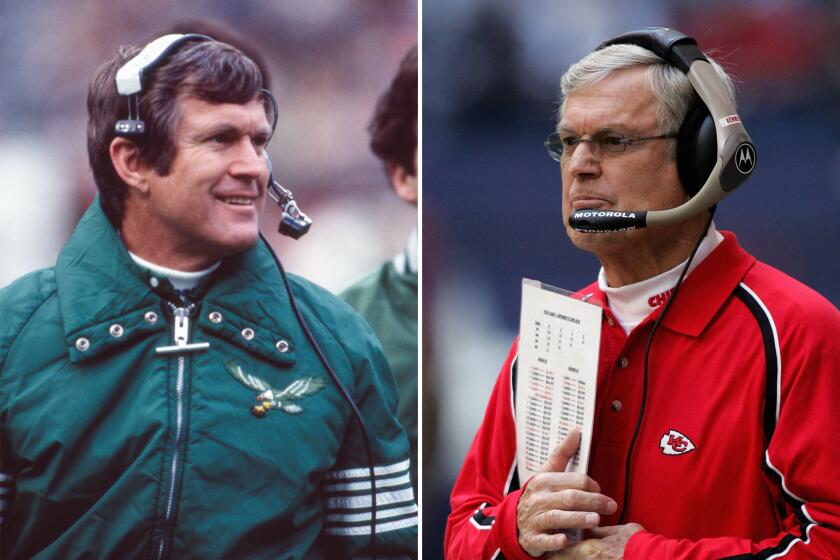Column: NFL’s schedule-making team and its 255 computers sift through trillions of options to arrive at the best slate

Cam Newton and the Carolina Panthers will face the Denver Broncos in a rematch of Super Bowl 50 in the 2016 season opener.
- Share via
Theirs is the NFL’s most secretive room. It’s on the fifth floor of the league’s Park Avenue headquarters, has glass that’s frosted opaque, soundproof walls, heavily encrypted computers, and can be accessed only by a special key card.
Even Commissioner Roger Goodell has to knock.
“We let him in,” Howard Katz said. “Everybody else, we ignore.”
See the most-read stories in Sports this hour>>
For the better part of four months at the start of every year, that room is essentially home to Katz, senior vice president of broadcasting, and three fellow league executives. They are entrusted to come up with the NFL’s regular-season schedule, which was unveiled this week, and have from the end of the previous season until mid-April to solve a spectacularly complex puzzle that gets more difficult by the year.
With 256 games, 17 weeks, six time slots, five networks and four possible game days — Sunday, Monday, Thursday and Saturday — there are hundreds of trillions of potential schedule combinations. Katz and his team are searching for the single best, and they have as many as 255 computers around the world running 24/7 to find the closest possible match to the ideal slate of games.
“Imagine you’re looking on the beach for the best grain of sand,” said Michael North, senior director of broadcast planning and the longest-tenured member of the scheduling foursome. “Your best hope is to drop as many people as you can on that beach, and drop them in all different places. Because you have no idea where on that beach the perfect grain of sand is.”
Many fans plan their lives around the schedule. The league regularly fields calls from people who need to know, say, if the Green Bay Packers will be at home on a certain Sunday for the purposes of making wedding, reunion or — in the case of one anxious Packer backer — vasectomy plans. When the 2016 schedule was released Thursday, ESPN devoted two solid hours to it, an hour less than NFL Network.
Because of the sophisticated technology at their disposal, the foursome — which also includes Onnie Bose, vice president of broadcasting, and Jonathan Payne, director of broadcast operations — can take far more into account now than when the schedule was assembled by hand a decade ago.
Among the scheduling elements that are factored in now, but were not deeply considered in the old days: How much is a team traveling, and how far? Is someone playing a road game against a team coming off its bye week? Is anyone playing a road game six days after being on the road on a Monday night? Is a club overloaded with consecutive opponents who made the playoffs the previous season? Has a team gone multiple seasons with its bye at Week 5 or earlier?
By today’s standards, many of the schedules of yesteryear would be neither playable nor feasible.
We’re throwing away schedules by the dozens now that certainly we would have played without batting an eye 10 years ago, and maybe as recently as five years ago.
— Howard Katz, NFL senior vice president of broadcasting
“We’re so much more sophisticated than we were,” said Katz, former president of ABC Sports. “We’re throwing away schedules by the dozens now that certainly we would have played without batting an eye 10 years ago, and maybe as recently as five years ago.”
The responsibility of building the schedule used to fall to legendary league executive Val Pinchbeck, who would assemble it over the course of months on a massive peg board with one hook for each game, and small circular fobs representing the teams. Think of the way keys are organized at a valet-parking station.
That peg board still remains in the scheduling room in memory of Pinchbeck, who died in 2004 after he was hit by a cab while crossing a Manhattan street. The scheduling room is named after him, and North — the lone holdover from the Pinchbeck era — arranges the fobs to correspond with each season’s new schedule.
There has been a significant paradigm shift since those days when the schedule was built, and then games were distributed to the networks. Now, TV is a consideration from the start, and there are several marquee games that are essentials around which the schedule is constructed.
“Once the pegs were on the board, you went back in and said, ‘OK, we’ll play this game on Monday night, play this game as a doubleheader,’ and things like that,” Bose told The Times this week in a conference call with the four schedule makers.
“In the 10 years that I’ve been doing this, the computer sophistication has grown exponentially. So now we have not only the ability but the mandate to take all these considerations in parallel. Yes, we focus very much on the television and making sure that our five networks have equitable and strong television packages, but we equally have to take into consideration the 32 teams and making sure that we’re not competitively disadvantaging to an extreme any one of those teams.”
Before the schedule is made, virtually every team submits its requests and suggestions to the league. Whenever possible, those are honored. For instance, the Rams asked that their Oct. 23 game in London be preceded by a game in the Eastern time zone, so the club could fly directly to England instead of heading back to Los Angeles. The league complied by scheduling the Rams at Detroit the Sunday before London.
The league would rather not see a team open with two road games, but that’s the case with the Packers this year. However, Green Bay hasn’t spent the first two weeks away from home since 1924, so Katz and his team reasoned once every 92 years was acceptable. (By comparison, that happened to Seattle twice in the previous five years.)
To weed through as many combinations as possible, the schedule makers come up with “rules” that serve as rough parameters for game placement. There were more than 26,000 of those associated with this year’s schedule, most of them having to do with television, competitive issues and stadium availability.
Some of the rules are nonnegotiable. For instance, the Oakland Raiders, who share their stadium with a baseball team, can’t play a home game when the A’s have a homestand. Other rules are more flexible. For instance, the NFL does not want to send a team on the road for three consecutive games, but sometimes it’s unavoidable.
A year ago, the NFL had a hard-and-fast rule that a team playing a London game would get its bye the following week. However, the league experimented with overseas day games last season — one that kicked off at 6:30 a.m. PT — and the New York Jets got home from London earlier than they would have had they played on the West Coast.
This year, teams playing in London were given a choice: They could either come back and get their bye, as the Rams will, or come back to a home game the following week and get their week off at some other point in the season.
Then there are the typical requests from teams, some of which are dismissed.
“Nobody wants to go to Buffalo or Green Bay in December, but somebody has to,” Katz said. “Nobody particularly wants to go to South Florida in September, but somebody has to. The notion of, ‘Don’t send me to Miami in September,’ we don’t pay attention to that.”
A few years ago, the schedule makers crunched their numbers on eight computers in the basement of NFL headquarters. Now, using a cloud-based system, they have access to a minimum of 85 computers, some based in Singapore, Belgium and across the Hudson River in New Jersey, and can increase that number to 255 when necessary.
Those computers spit out 43,399 playable schedules this year, each of which was given a score based on how closely it adhered to those 26,000 rules. The schedule ultimately chosen was No. 43,066.
“After we found that schedule and said, ‘Yeah, we could definitely play this,’ we looked at another 333 schedules to see if we could find anything better,” Katz said.
“Having said that, we barely scratched the surface. The universe is so vast that we know we found a good schedule. We also know that, given unlimited computer power and an unlimited amount of time, there’s a better schedule out there. It’s just unlikely that we’re going to find it in any reasonable time frame.”
Typically, the schedule comes out around the third week of April, although there’s no set deadline. On Tuesday, Katz crossed paths with Goodell in the NFL lunchroom, the Huddle Cafe, and gave him the good news.
“I called him over to the table and said, ‘The reality is, we have a schedule that we’re pretty happy with. We haven’t beaten it in eight days, and I’m not sure we’re going to.’”
The next day, the commissioner met with the schedule makers for more than two hours.
“We took him through everything,” Katz said. “He asked a lot of questions, pushed back on a bunch of things, wanted to make sure he understood it thoroughly. At the end he said, ‘Yeah, this is good.’”
A day later, the NFL unveiled it to the waiting sports world.
Follow Sam Farmer on Twitter @LATimesfarmer
More to Read
Go beyond the scoreboard
Get the latest on L.A.'s teams in the daily Sports Report newsletter.
You may occasionally receive promotional content from the Los Angeles Times.











